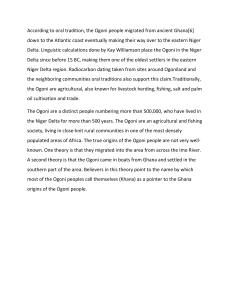Contents - Mangrove Action Project
advertisement
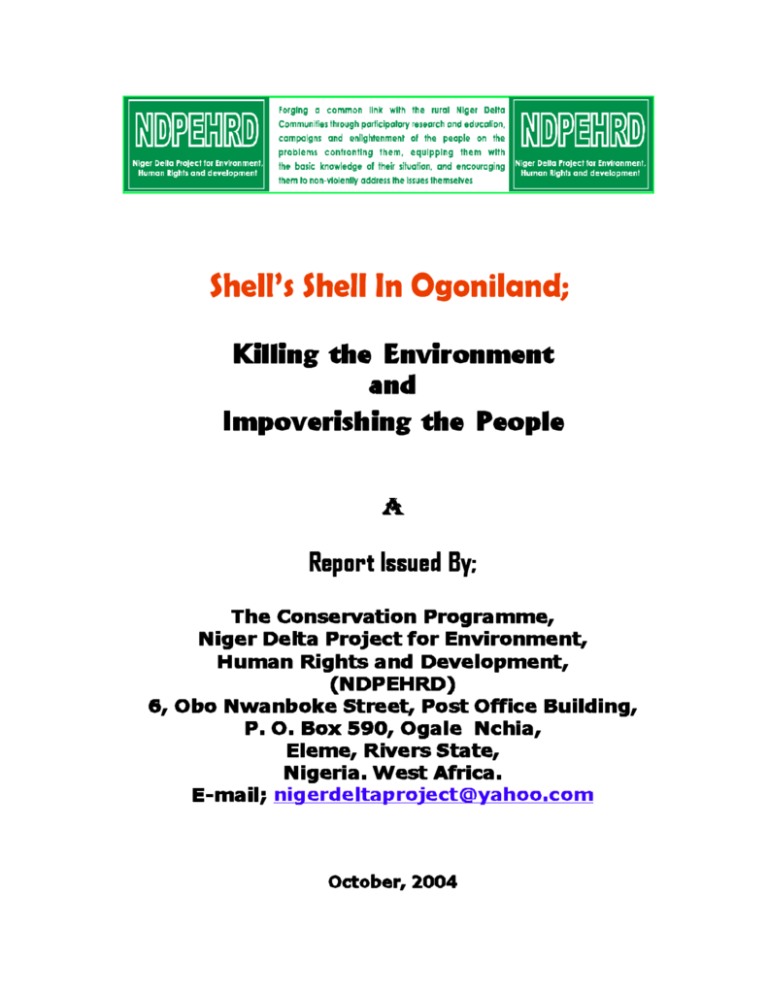
2 Contents 1. Introduction 2. Mogho Oil Spill 3. Communities Affected 4. Cause(s) of the Spill 5. Oil Spill Response 6. Impacts 7. Inevitable Fears 8. Recommendation 3 1. INTRODUCTION Crude oil spillages are a regular occurrence in the Niger Delta region of Nigeria where over 80% of the country’s crude oil is produced. Sources of crude oil pollution include drilling and production operations, pipelines, manifolds, hoses, oil tankers, barges, oil terminals and depots (Odiete, 1999)1. Dublin-Green et al, (1998)2 reported that from 1979 – 1997, the Nigerian Petroleum industry suffered 5334 cases of oil spillage resulting in the discharge of 2.8 million barrels of oil into the land, swamps, estuaries and coastal waters. However, some incidents of oil spillage in the Niger Delta are oftentimes not reported or perhaps, rated minor without post-spill remediation measures. Ogoni, located in the south-eastern part of the lower Niger Delta is endowed with abundant natural resources including oil and gas. While oil was first struck in commercial quantities at Oloibiri, Bayelsa State, 1956, Bomu (an Ogoni town) was the second point of commercial oil discovery (1958) in the annals of Nigeria’s petroleum industry. Ogoni thus plays host to five flow stations and 96 oil wells. Despite the suspension of oil exploration and exploitation activities in Ogoni since 1993, the area is yet to be spared from oil spillages. Oil pipelines criss-cross Ogoni landscape some of which are trans-Niger trunk lines that transport oil to shipment terminal in Bonny Island. On August 25, 2003 some littoral Ogoni communities in Gokana Local Government area experienced tremendous oil spillage for no less than a week. Barely one year and a month later, these same areas suffered another crude oil pollution (spillage) which is highly devastating in scope. 2. 1. Odiete, W. O. 1999; Environmental Physiology of Animals and Pollution. Diversified Resources, Lagos, Nigeria, Page 204. 2. Dublin-Green, W. F. Nwankwo, J. N. and Irechukwu, D. O. 1998: Effective Regulation and Management of HSE issues in the Petroleum History; S.PE International Conference on Health, Safety and Environment in Oil and Gas MOGHO OIL SPILL Exploration and Production, Caracas, Venezuela, 7-10, June, 1998. Paper No. SPE 40/26 4 2. MOGHO OIL SPILL On the 11th October, 2004, oil spilled at an Ogoni town called Mogho. Mogho is one of the seventeen towns in the Gokana Kingdom of Ogoni (administratively located in the Gokana Local Government Area of Rivers State). Lying approximately on latitude 4039’11” N and latitude 7017’15” E, Mogho is situated on the coastal lowland of the Niger Delta, South-East of Port Harcourt, the Rivers State capital, and about ten nautical (or sea) miles off the Bonny River (Vikoo, 2003)3. On the above mentioned day, at “Saanako” swamp in Mogho, along Shell’s 24 inches Trans-Niger Pipeline4, a major leakage occurred which resulted in the spewing of quantum volume of crude oil, yet to be quantified into the swampy environment. The oil gushed out steadily for over 24 hours before stoppage. The affected spill locality being a wetland (tropical swamp) has a fresh water stream which drains waters from upland and flows unidirectionally downstream before it discharges into an estuarine mangrove sheltered environment at a neighbouring community called Goi. Thus, the spilled oil which covered the surface of the swamp water flows along gradient and steadily, emptying into the denser brackish water of Goi. From Goi, tidal fluxes spread the oil scum to neighbouring littoral communities. Flood and ebb tides carried the oil sleek to every nook and cranny of the affected communities’ water environment. Oil become stranded and formed oil pools on sandy and muddy inter-tidal depressions during receding tides. Tidal pumping causes oil percolation into sediments. The oil was later inflamed from a yet to be identified source. Consequently, the whirl fire trailed the spread of the oil. 3. COMMUNITIES AFFECTED Whereas, Mogho and Goi are the epicenters of the spill incident and effects, other bounded communities with interconnectivity of creeks were also affected. The communities are Bodo city, K-Dere and Kpor all in the Gokana Local Government Area of Ogoni, Rivers State. 3. Vikoo, B. 2003 “The Mogho People and the Development of modern Ogoni Nation” Springfield, Owerri, Nigeria, Page 1 4. The Shell’s Trans Niger Pipeline runs through Ogoni communities and other communities to Bonny Island, Rivers State. 5 4. CAUSE(S) OF THE SPILLAGE The cause(s) of the oil spillage is/are still shrouded in mystery. This could be determined if thorough investigation is done. However, the owners of the leaked pipeline, Shell Nigeria in her traditional style of avoiding responsibilities had issued a press statement blaming the spillage on sabotage even before sending out field inspectors and fire fighters to the affected sites. 5. OIL SPILL RESPONSE No other post-spill responses have been embarked on beyond extinguishing the fire and plastering the leaking pipe. These dual measures were undertaken simply to enhance the continuous streaming of oil to Bonny terminal for shipment rather than the concern for the environment. This presumption stems from the fact that even the simple physical method of crossing creek channels with floating booms to prevent further downstream spread of oil has been neglected by the oil giant. 6. IMPACTS The oil flame gutted tropical rainforest and mangrove trees to an estimated range of about 30km2. Arable crops like cassava, yam, three leaf yam, etc on farmlands fringing the affected “Saanako” swamp forest down to Goi where not spared either. The lush and thickly mangrove forest swamp of Goi is now better remembered. Mangrove trees primarily dominated by Rhizophora Spp (red mangrove) and sparse stands of Avicenia africana (white mangrove) pockets of mangrove fern (Acrosticum aureum) and Palsparum vaginatum, the mangrove sedge which creeps high intertidal marks were all burnt down. During full tide, when field assessment was done, only the stumps of burnt hanging roots of red mangrove trees, protruding 4-8cm above the water surface depicted the pre-spill mangrove density lost to the inferno. As a rule of thumb, the primary productivity of the impacted areas will fall drastically. This is because oil films would affect the production of microphytes (phytoplankton) which contribute greatly in association with mangrove leaf litters (detritus) to the primary productivity budget 6 of the local aquatic environment. This is so as the algae (phytoplankton) are deprived of oxygen, radiant heat and light. The Biochemical Oxygen Demand (BOD) will increase with a drop in pH resulting in anoxic conditions that will favour the algal bloom of the opportunistic blue-green algae and dinoflagelates which contribute little (in terms of quality) to the aquatic food chain (Hart, 1997)5. The shores have lost their compactment and stability. Along the snaky stream, right from the spilled spot to the point of freshwater – brackish water transition, the pre-spill water saturated soil have dried up, lost cohesion and turns vulnerable to riparian erosion. This is shown by visible soil cracks, in blocks along the water banks following three successive rains after the fire was extinguished. Dug-out canoes used by poor fisher folks, local sand dredgers etc anchored in the vicinity of Goi landing site were burnt to ashes. Fishing nets routinely spread on stakes for drying after fishing were also engulfed. Set gill nets, beach seine, pens and other fishing gears and enclosures in the affected water web are tainted by oil scum and made useless. Oil also sleeked into three brackish water ponds situated at Goi. The ponds ranging from 0.1 - 0.3 ha in perimeter belong to one Chief Barizaa Dooh, a 68-year old commercial farmer and transporter. The polycultured fish ponds had in stock tilapia (Sarotherodon sp) red snapper (Lutjanus goreensis) and catfish (Chrysichthys nigrodigitatus), all commercially important species killed by the toxicity of hydrocarbons and abnormal temperature increase occasioned by the fire factor. Other local fauna within the impacted geographic area were dead or seen moribund as at the time of field investigations by NDPEHRD. Carcasses of fin fish were washed ashore. Sedentary or relatively less mobile bottom dwelling fauna were the hard hit. Dietary crustaceans such as the hairy mangrove crab 5. Hart, S. A. 1997; Effects of crude oil pollution on the Niger Delta. An M. Sc seminar paper presented to the Department of Zoology, University of Port Harcourt, Port Harcourt, Nigeria, 2 September, 1997. 7 (Gionopsis pilli) fiddler crab (Uca tangeri), Sersamid crabs (Sersama huzardi, Sersama elegans), and Swimming crabs (Callinectes spp) were decimated. Mollusks endemic in the area like Periwinkle (Tympanotonus fuscatus, Pachymelaria sp), dog whelk (Thais spp), Oyster (Crassostrea gasar) were affected6. Presently, the actual lethal and sublethal impact of the oil spill on local biota cannot be quantified unless a detailed environmental impact evaluation survey is conducted by experts. It is sad to point out that, no baseline information exist on the biodiversity of the impacted areas (published or unpublished) for possible references if need be, should the above mentioned investigation is conducted. 7. INEVITABLE FEARS The oil spill incident that took place in August, 2003 in Gokana littoral waters which affected these same communities remains also unclean till the time of this report. Secondly, as the grossly defoliated and suffocating mangrove belt especially along Bodo city creek is now reimpacted by crude oil, when the said mangrove swamps have not shown signs of recovery calls for worry. In addition, oil percolating into sediments due to tidal pumping is building up the accumulated hydrocarbon concentration already buried in the affected areas. This suggests the durable extent to which the oil degradation would last. 6. Photographs of the devastated sites and other sites of significance in the area are available at NDPEHRD’s Secretariat. 8 8. RECOMMENDATIONS NDPEHRD7 therefore, recommendations. 7. proffers the under-listed urgent 1. Immediate clean up and restoration of the oiled environment. 2. Government regulatory agencies should ensure that a detailed investigation into the impacts of the spillage is carried out immediately. 3. Ecological surveys should be carried out to obtain checklists of flora and fauna in the fragile Niger Delta basin. 4. Adequate and independent inquiry to finding cause(s) of the spillage be undertaken and commensurate compensations be paid to affected persons and communities, and 5. Oil companies should adopt operations and technology that are friendly to the environment and also re-new pipelines when due, to forestall avoidable spillages This small report was researched and prepared by Mr. Nennibarini Zabbey, head of the Conservation Programme of Niger Delta Project for Environment, Human Rights and Development (NDPEHRD). The organization is a rural-based, rural-focused and non-profit making organization, founded on August 15, 1999, to respond to the problems of environment, human rights, rural health and population and under-development plaguing the Niger Delta region of Nigeria through participatory research, enlightenment and campaigns on the problems confronting the peoples of the belt.

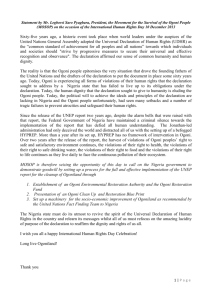
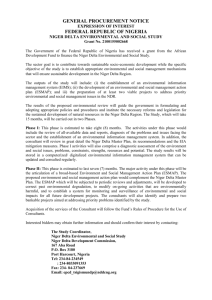

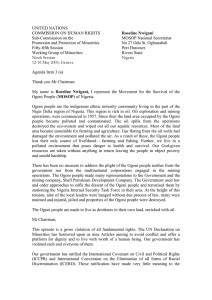

![Kwadijk-Deltatechnology presentation [Compatibiliteitsmodus]](http://s2.studylib.net/store/data/005765666_1-8750ea686d0c834b2bb5a5055d5c4a69-300x300.png)


